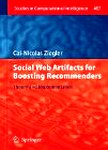版权所有:内蒙古大学图书馆 技术提供:维普资讯• 智图
内蒙古自治区呼和浩特市赛罕区大学西街235号 邮编: 010021

丛 书 名:Studies in Computational Intelligence
版本说明:2013
I S B N:(纸本) 9783319005263
出 版 社:Springer International Publishing
出 版 年:2013年
主 题 词:Recommender systems (Information filtering) Data mining
学科分类:12[管理学] 1201[管理学-管理科学与工程(可授管理学、工学学位)] 08[工学] 081201[工学-计算机系统结构] 0812[工学-计算机科学与技术(可授工学、理学学位)]
摘 要:Recommender systems, software programs that learn from human behavior and make predictions of what products we are expected to appreciate and purchase, have become an integral part of our everyday life. They proliferate across electronic commerce around the globe and exist for virtually all sorts of consumable goods, such as books, movies, music, or *** the same time, a new evolution on the Web has started to take shape, commonly known as the Web 2.0 or the Social Web: Consumer-generated media has become rife, social networks have emerged and are pulling significant shares of Web traffic. In line with these developments, novel information and knowledge artifacts have become readily available on the Web, created by the collective effort of millions of *** textbook presents approaches to exploit the new Social Web fountain of knowledge, zeroing in first and foremost on two of those information artifacts, namely classification taxonomies and trust networks. These two are used to improve the performance of product-focused recommender systems: While classification taxonomies are appropriate means to fight the sparsity problem prevalent in many productive recommender systems, interpersonal trust ties when used as proxies for interest similarity are able to mitigate the recommenders scalability problem.